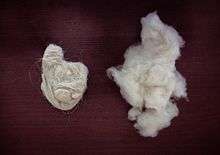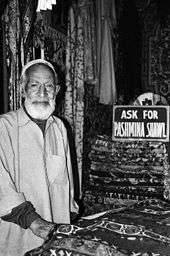Pashmina
Pashmina is a fine type of Kashmiri wool. The textiles made from it were first woven in Kashmir.[1][2] The name comes from Persian: پشمینه / pašmina, meaning "made from wool"[2] and literally translates to "Soft Gold" in Kashmiri.[3] Pashmina came to be known as 'cashmere' in the West because Europeans first encountered this fibre in Kashmir.[4] The wool comes from four distinct breeds of the Cashmere goat; namely the Changthangi or Kashmir Pashmina goat from the Changthang Plateau in Kashmir region, the Malra from Kargil area in Kashmir region, the Chegu from Himachal Pradesh in northern India, and Chyangara or Nepalese Pashmina goat from Nepal. These shawls are hand spun, and woven in Kashmir and Nepal, and made from fine cashmere fibre.[1][5]

History
Woven shawls in what is now India have been worn as early as the Indus Valley Civilisation. A famous example is the statue of a priest-king found at Mohenjo-Daro, who is draped in a shawl decorated with trefoil patterns.
Woolen shawls made in Kashmir are mentioned in Afghan texts between the 3rd century BC and the 11th century AD.[6] However, the founder of the pashmina industry is traditionally held to be the 15th century ruler of Kashmir, Zayn-ul-Abidin, who introduced weavers from Central Asia. Other sources consider pashmina crafts were introduced by Mir Sayyid Ali Hamadani[7] who, as tradition has it, arrived to Kashmir from Persia along with 700 craftsmen.[8]
Pashmina shawls have been worn by the royalty and the elites in the region for centuries. Pashmina blankets were also vital additions to a wealthy women's dowry in India and Nepal. They are a status symbol in the East.[9]
Both pashmina and cashmere are derived from the mountain goat (Capra hircus). One distinct difference between pashmina and generic cashmere is the fibre diameter. Pashmina fibres are finer and thinner (12–15 microns) than generic cashmere fibre (15–19 microns)[10] and therefore ideal for making lightweight apparel like fine scarves. As the fibre diameter is very low, pashmina has to be hand-processed and woven into products such as shawls, scarves, wraps, throws, stoles, etc. However, the quality of a finished shawl is not solely dependent on the fibre diameter of the wool but also on the craftsmen's skills. Pashmina products are made only in Kashmir and more recently in Nepal where the industry has seen a surge in production. Kashmir hand made pashmina shawl is 100% pashmina because the thread is hand spun, whereas machine made can be mixed easily with simple wool and acrylic.
Today, however, the word "Pashmina" is used indiscriminately, and many scarves made from natural or synthetic fiber are sold under the name "Pashmina", creating confusion in the market. . The exorbitant price of a real pashmina shawl is due to the amount of expert craftsmanship that goes into creating each shawl and the rarity of the pashmina wool – the wool is used in an authentic Kashmiri pashmina comes from the Changthangi breed of the Capra hircus goat and this breed constitutes less than 0.1% of global cashmere production.
Production
The Pashmina goat or Changthangi as it's called in Kashmir, sheds its winter coat every spring. One goat sheds approximately 80–170 gram (3–6 ounces) of the fibre. See also Cashmere wool.
In the spring (the moulting season), the goats naturally shed their under fleece, which regrows in winter. This under fleece is collected by combing the goat, not by shearing, as in other fine wools. Unlike other Cashmere goats, the Pashmina goat not only feeds on the grass but also the roots of the grass. The traditional producers of Pashmina Wool in the Ladakh region of Indian Administered Jammu and Kashmir are a tribe known as the Changpa. They are a nomadic people and inhabit the Changthang plateau of the Kashmir region, which has a lowest altitude of 13,500 feet above the sea level and the winter temperature drops to −40 degree Celsius. The Changpa rear sheep in these harsh climes for meat and pashmina goats for wool.[11]
The raw Pashmina wool is then transported to the valley of Kashmir in northern India, where it is entirely hand processed. All steps from combing (removing impurities and guard hair, and aligning fibers) and spinning, to weaving and finishing, are entirely carried out by hand by specialized craftsmen and women. The major centre of Pashmina fabric production is the old district of Srinagar, capital of Indian Administered Jammu and Kashmir. The approximate craft time put into producing a single Pashmina stole (70x200cm) is 180 hours.
Pashmina products

Pashmina accessories are available in a range of sizes, from "scarf" 12 in × 60 in (0.30 m × 1.52 m) to "wrap" or "stole" 28 in × 80 in (0.71 m × 2.03 m) to full sized shawl 36 in × 80 in (0.91 m × 2.03 m) and in rare cases, "Macho" 12 ft × 12 ft (3.7 m × 3.7 m). Pure pashmina is a rather gauzy, open weave, as the fibre cannot tolerate high tension. The most popular pashmina fabric is a 70% pashmina/30% silk blend, but 50/50 is also common. The 70/30 is tightly woven, has an elegant sheen and drapes nicely, but is still quite soft and light-weight.
They are known for their softness and warmth. A craze for pashminas in the mid-1990s resulted in high demand for pashminas, so demand exceeded supply. When pashmina shawls rose into fashion prominence during the era, they were marketed dubiously. In the consuming markets, pashmina shawls have been redefined as a shawl/wrap with cashmere and cashmere/silk, notwithstanding the actual meaning of pashmina. Some shawls marketed as pashmina shawls contain wool,[1] while other unscrupulous companies marketed the man-made fabrics such as viscose and others as "pashmina" with deceptive marketing statements such as "authentic viscose pashmina".
The word "pashmina" is not a labeling term recognized by law in the United States. According to the U.S. Federal Trade Commission:
Some manufacturers use the term pashmina to describe an ultra fine cashmere fiber; others use the term to describe a blend of cashmere and silk. The FTC encourages manufacturers and sellers of products described as pashmina to explain to consumers, on a hangtag, for example, what they mean by the term.
As with all other wool products, the fiber content of a shawl, scarf or other item marketed as pashmina must be accurately disclosed. For example, a blend of cashmere and silk might be labeled 50% Cashmere, 50% Silk or 70% Cashmere, 30% Silk, depending upon the actual cashmere and silk content. If the item contains only cashmere, it should be labeled 100% Pashmina or All Cashmere, by the Wool Act or regulations.[12]
See also
- Shahmina – a type of shawl made in Kashmir from Pashmina with a fiber diameter of 13 micrometres or less
- Shahtoosh – a fine type of shawl, now illegal, hand-woven in Kashmir using the down hair of the endangered Tibetan antelope
References
- 1 2 3 Franck, Robert R. (October 2001). Silk, Mohair, Cashmere and Other Luxury Fibres. Woodhead Publishing. p. 142. ISBN 1-85573-540-7. Retrieved 2008-07-08.
- 1 2 "Pashmina." The Oxford English Dictionary. 2nd ed. 1989.
- ↑ Shakyawar, D B; Raja, A S M; Ajay, Kumar; Pareek, P K; Wani, S A. "Pashmina Fibre – Production, Characteristics and Utilization" (PDF). Indian Journal of Fibre and Textile Research. Indian Journal of Fibre and Textile Research. Retrieved 11 May 2015.
- ↑ Ahmed, Monisha (2004). "The Politics of Pashmina: The Changpas of Eastern Ladakh". Nomadic Peoples. 8: 91. JSTOR 43123726.
- ↑ Morse, Linda; Lidia Karabinech; Lina Perl; Colby Brin (October 2005). Luxury Knitting: The Ultimate Guide to Exquisite Yarns. Sterling Publishing. p. 12. ISBN 1-931543-86-0. Retrieved 2008-07-08.
- ↑ Encyclopædia Britannica (2008). kashmir shawl.
- ↑ Shereza number (2004) Kashmir Academy Arts and Culture (edit.), Jeelani Allaie kashmeri
- ↑ UNESCO report 2014 by Jeelani Allaie
- ↑ Reis, José; Varela, Gonzalo (October 2013). "Can Tourism Encourage Better Export Performance and Diversification in Nepal?". The World Bank.
- ↑ "Pashmina Technical Data – Department of Animal Husbandary, Government of Indian Administered Jammu and Kashmir".
- ↑ Prem Singh Jina (1996). Ladakh: The Land and the People. Indus Publishing. pp. 258–. ISBN 978-81-7387-057-6. Retrieved 5 August 2012.
- ↑ "Cachet of Cashmere: Complying with the Wool Products Labeling Act". Bureau of Consumer Protection, Trade Commission. Archived from the original on 9 April 2014. Retrieved 11 May 2014.
External links




.svg.png)